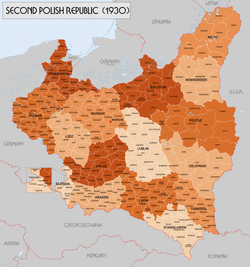


Subdivisions of the Second Polish Republic became an issue immediately after the creation of the Second Polish Republic in 1918. The Polish–Lithuanian Commonwealth had been partitioned in the late 18th century. The various parts of what was now Polish territory had belonged to different states with different administrative structures: Austria-Hungary (mostly forming part of the Kingdom of Galicia and Lodomeria), the German Empire (specifically the Kingdom of Prussia) and the Russian Empire.
In 1919 the first voivodeships of interwar Poland were created; in addition, the capital of Warsaw had the status of an independent city-voivodeship. In the years 1919–1921 additional voivodeships were created, as borders of Poland were still fluid, with events such as the Silesian Uprisings in the West and the Polish-Soviet War in the East. Eventually by 1921 Poland would have 15 voivodeships, the Warsaw capital city-voivodeship and the Autonomous Silesian Voivodeship (the system known as 15+1+1). Additionally, the creation of the new Sandomierz Voivodeship was planned for late 1939.
The lower level of administration, below voivodeships, were powiats (counties). They were subject to several reforms, particularly in early and late 1930s. Below them were gminas and gromadas. Shortly before the Second World War, in April 1939, Poland had 264 powiats, 611 urban and 3195 rural gminas and 40533 gromads.
The division was based on a three-tier system. On the lowest rung were the gminy, which were little more than local town and village governments. These were then grouped together into powiaty which were then arranged into województwa.
| Car plates (since 1937) |
Coat of arms | Voivodeship Separate city |
Capital | Area in 1000 km2 (1930) |
Population in 1000s (1931) |
|---|---|---|---|---|---|
| 00-19 |  |
City of Warsaw | Warsaw | 0.14 | 1179.5 |
| 85-89 |  |
warszawskie | Warsaw | 31.7 | 2460.9 |
| 20-24 |  |
białostockie | Białystok | 26.0 | 1263.3 |
| 25-29 |  |
kieleckie | Kielce | 22.2 | 2671.0 |
| 30-34 |  |
krakowskie | Kraków | 17.6 | 2300.1 |
| 35-39 |  |
lubelskie | Lublin | 26.6 | 2116.2 |
| 40-44 | lwowskie | Lwów | 28.4 | 3126.3 | |
| 45-49 |  |
łódzkie | Łódź | 20.4 | 2650.1 |
| 50-54 |  |
nowogródzkie | Nowogródek | 23.0 | 1057.2 |
| 55-59 |  |
poleskie | Brześć nad Bugiem | 36.7 | 1132.2 |
| 60-64 |  |
pomorskie | Toruń | 25.7 | 1884.4 |
| 65-69 |  |
poznańskie | Poznań | 28.1 | 2339.6 |
| 70-74 |  |
stanisławowskie | Stanisławów | 16.9 | 1480.3 |
| 75-79 ? |  |
śląskie (autonomous) | Katowice | 5.1 | 1533.5 |
| 80-84 |  |
tarnopolskie | Tarnopol | 16.5 | 1600.4 |
| 90-94 |  |
wileńskie | Wilno | 29.0 | 1276.0 |
| 95-99 |  |
wołyńskie | Łuck | 35.7 | 2085.6 |
On April 1, 1938, the borders of several western Voivodeships changed considerably. For more information, see Territorial changes of Polish Voivodeships on April 1, 1938.
Total number of Voivodeships - 16, plus the capital city of Warsaw, which was regarded as a separate unit.
Total number of counties (as of August 1, 1939) - 264, including 23 urban counties.